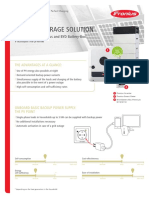Thermal Analysis (ATH)
Thermal Analysis (ATH)
Uploaded by
liapomiCopyright:
Available Formats
Thermal Analysis (ATH)
Thermal Analysis (ATH)
Uploaded by
liapomiCopyright
Available Formats
Share this document
Did you find this document useful?
Is this content inappropriate?
Copyright:
Available Formats
Thermal Analysis (ATH)
Thermal Analysis (ATH)
Uploaded by
liapomiCopyright:
Available Formats
Analysis
Thermal Analysis (ATH)
CATIA V5R21
Analysis
Thermal Analysis
Extends the capabilities of Generative Part Structural Analysis (GPS) to thermal analysis.
Product overview Thermal Analysis (ATH) extends the capability of GPS, allowing designers to understand the thermal behavior of their designs. The steady-state or transient temperature distribution can be calculated in response to direct heating of a surface, the flow of a fluid past a surface, or the specified temperature of the surface. The thermal material properties can be temperature dependent. When analyzing assemblies, the conductivity across the interface between contacting parts can be specified. Product Key Customer Benefits When ATH is used in conjunction with Nonlinear Structural Analysis (ANL), a new class of analysis problems can be tackled. Nonlinear structural analysis can be performed including the effects of the temperature distribution calculated by ATH, which can cause parts to expand and contract and also affect their material properties. In addition to the functionalities and benefits provided by Generative Part Structural Analysis (GPS), Thermal Analysis (ATH) offers: Thermal analysis ATH enables the temperature distribution in a part or an assembly to be determined, allowing designers to understand the thermal behavior of their designs. The calculated temperature distribution can be used to perform a thermal stress analysis in Nonlinear Analysis (ANL) to study the effect of thermal-induced stresses and potential fatigue problems that they may cause. The steady-state capability allows the long-term temperature distribution to be determined. ATH also has the ability to analyze the transient thermal response, such as the effect of a thermal shock or a start-up event. Thermal loading A heat flux can be applied to a point, surface
Product Highlights Calculates the temperature distribution in a part or assembly. Determines the steady-state or transient thermal response. Material properties can be temperature dependent. Allows the conduction of heat between parts in an assembly. Enables thermal stress analysis when used in conjunction with ANL.
Copyright 2002-2008 Dassault Systemes - All rights reserved
or volume, modeling the effect of direct heating. A film condition can also be applied to surfaces, modeling the effect of a fluid such as air or water next to the surface. The bulk temperature of the fluid and the heat transfer coefficient between the fluid and the structure must be defined. The temperature of the model parts can also be specified directly. Spatially varying thermal loads can be applied through the data mapping functionality. Thermal materials For a steady-state analysis, the conductivity of the material must be defined; for a transient analysis the density and specific heat is also required. The conductivity and specific heat can be specified to be temperature dependent, which is common for many materials. When temperature-dependent materials are included, the solution becomes nonlinear, and ATH will automatically perform a nonlinear analysis. Thermal analysis of assemblies A thermal analysis of an assembly can be performed. ATH will automatically locate surfaces on adjacent parts and create thermal contact between them. The thermal conductivity across these contacting surfaces can be defined so that the surfaces conduct heat appropriately, depending on the size of the gap and the temperature at each surface. Results interpretation Contours of the temperature distribution in the part or assembly can be plotted. For a transient analysis, the temperature distribution can be plotted at various times during the transient and then animated. X-Y plots showing the time variation of the temperature at points in the model can also be plotted.
Copyright 2002-2008 Dassault Systemes - All rights reserved
Other images
Copyright 2002-2008 Dassault Systemes - All rights reserved
ABOUT CATIA V5R21
CATIA is Dassault Systemes' PLM solution for digital product definition and simulation.
www.3ds.com/products/catia
For more information about our products visit www.3ds.com/contact Copyright 2002-2008 Dassault Systemes - All rights reserved
You might also like
- Catia - Fem Surface 2 (FMS)Document4 pagesCatia - Fem Surface 2 (FMS)liapomiNo ratings yet
- CATIA - Generative Assembly Structural Analysis 2 (GAS)Document5 pagesCATIA - Generative Assembly Structural Analysis 2 (GAS)liapomiNo ratings yet
- CATIA - Generative Assembly Structural Analysis 2 (GAS)Document5 pagesCATIA - Generative Assembly Structural Analysis 2 (GAS)liapomiNo ratings yet
- Catia - Fem Surface 2 (FMS)Document4 pagesCatia - Fem Surface 2 (FMS)liapomiNo ratings yet
- 2016 BIOLOGY EOC Study Guide ANSWER KEY and Content Focus PDFDocument9 pages2016 BIOLOGY EOC Study Guide ANSWER KEY and Content Focus PDFMelisa Anne CanilangNo ratings yet
- English Exercise Topic 2 (Yohanes Andryano - 811121065)Document8 pagesEnglish Exercise Topic 2 (Yohanes Andryano - 811121065)Yo TampNo ratings yet
- Catia - Knowledge Advisor 2 (Kwa) BroucherDocument5 pagesCatia - Knowledge Advisor 2 (Kwa) BroucherCarlos PregoNo ratings yet
- Catia v5-6r2016 What S NewDocument72 pagesCatia v5-6r2016 What S NewD-No CteNo ratings yet
- GpsDocument5 pagesGpstanhuyhcmutNo ratings yet
- CATIA - Electrical System Functional Definition 2 (EFD)Document4 pagesCATIA - Electrical System Functional Definition 2 (EFD)mohan_babu007100% (1)
- Catia V5R18: CATIA - Electrical Library 2 (ELB)Document5 pagesCatia V5R18: CATIA - Electrical Library 2 (ELB)Aron VanNo ratings yet
- Creating Loft Surfaces Icem - Surf DesignDocument1 pageCreating Loft Surfaces Icem - Surf Designokupa06No ratings yet
- CATIA - Elfini Structural Analysis (EST)Document5 pagesCATIA - Elfini Structural Analysis (EST)liapomiNo ratings yet
- Zavarivanje Catia PDFDocument316 pagesZavarivanje Catia PDFdjuka65No ratings yet
- Angle Encoder 365C PS 2010 ENG NeuDocument2 pagesAngle Encoder 365C PS 2010 ENG NeuNishanth.M nishuNo ratings yet
- Ansa v11.3.6 Release NotesDocument111 pagesAnsa v11.3.6 Release Notessuhas110No ratings yet
- Converters and CAD/CAM InterfacesDocument116 pagesConverters and CAD/CAM Interfaceschicho6404No ratings yet
- Dassault Systemes Catia Configurations PDFDocument2 pagesDassault Systemes Catia Configurations PDFInam Ul HaqNo ratings yet
- Ansa v13.1.2 Release NotesDocument18 pagesAnsa v13.1.2 Release Notesharsh14363No ratings yet
- CATIA in Admin ModeDocument2 pagesCATIA in Admin ModeOvidiu PopNo ratings yet
- Product Data Filtering: User's GuideDocument34 pagesProduct Data Filtering: User's GuideashkansoheylNo ratings yet
- V5 CATIA Learning Paths Nov2016Document63 pagesV5 CATIA Learning Paths Nov2016limboyNo ratings yet
- Edu Cat en MMG FX v5r19 ToprintDocument56 pagesEdu Cat en MMG FX v5r19 ToprintAdi FieraNo ratings yet
- CATIA - Plant Layout 1 (PLO) PDFDocument5 pagesCATIA - Plant Layout 1 (PLO) PDFDaniel Ab100% (1)
- Dassault Systemes Catia ConfigurationsDocument2 pagesDassault Systemes Catia ConfigurationsHsin-Hung YuNo ratings yet
- 89 EngDocument27 pages89 EngrajuhaveriNo ratings yet
- Creating Parameters and Design Table With A MacroDocument10 pagesCreating Parameters and Design Table With A MacroFernando PetreNo ratings yet
- CATIA Products List1Document12 pagesCATIA Products List1api-3757236No ratings yet
- 87 EngDocument35 pages87 EngrajuhaveriNo ratings yet
- Composites 2022xDocument52 pagesComposites 2022x安澜No ratings yet
- Wfsug - Wireframe and Surface PDFDocument522 pagesWfsug - Wireframe and Surface PDFcmm5477No ratings yet
- Edu Cat e SMD Uf v5r8Document21 pagesEdu Cat e SMD Uf v5r8Mehdin MujanovicNo ratings yet
- Catia PDFDocument4 pagesCatia PDFLal Krrish MikeNo ratings yet
- Edu Cat e Amg FF v5r9Document32 pagesEdu Cat e Amg FF v5r9Kmt_AeNo ratings yet
- Syllabus CATIA CAA RADEDocument1 pageSyllabus CATIA CAA RADEDhanasekaran KumaranNo ratings yet
- Leveraging Security Mask On 3DEXPERIENCE Platform: Best PracticesDocument38 pagesLeveraging Security Mask On 3DEXPERIENCE Platform: Best PracticesBrady PittNo ratings yet
- CATIA V5 Tips : Nodes Customization in The CATIA Specification TreeDocument10 pagesCATIA V5 Tips : Nodes Customization in The CATIA Specification TreerajeshNo ratings yet
- EDU CAT EN V5E AF V5R16 Lesson7 Toprint7 PDFDocument189 pagesEDU CAT EN V5E AF V5R16 Lesson7 Toprint7 PDFleydonhdNo ratings yet
- Human Activity Analysis PDFDocument63 pagesHuman Activity Analysis PDFJavier Lopez PereiraNo ratings yet
- DS WhitePapers 3DEXPERIENCE R2020x CATSettings Use and Recommendations V1.0Document43 pagesDS WhitePapers 3DEXPERIENCE R2020x CATSettings Use and Recommendations V1.0Sam AntonyNo ratings yet
- VAMOS CAA V5 Based: Progressive DiesDocument4 pagesVAMOS CAA V5 Based: Progressive DiesRodolfo GarciaNo ratings yet
- Presentation On Advanced Applications of Fea, NVH, CFD, Crash, Fatigue, ManufacturingDocument14 pagesPresentation On Advanced Applications of Fea, NVH, CFD, Crash, Fatigue, Manufacturingketankhedkar21No ratings yet
- Brochure Wiring Harness Engineering SolutionsDocument12 pagesBrochure Wiring Harness Engineering Solutionsarun.nagarkarNo ratings yet
- Machining CatiaDocument327 pagesMachining Catiabodo87_eugenNo ratings yet
- Solutions Course Title Course Code DVD NumberDocument1 pageSolutions Course Title Course Code DVD NumberGokul Prabu0% (1)
- 3d Modeling Fea CATIA v5Document25 pages3d Modeling Fea CATIA v5Jasime IhocuNo ratings yet
- CATIA - Generative Dynamic Response Analysis 2 (GDY)Document4 pagesCATIA - Generative Dynamic Response Analysis 2 (GDY)liapomiNo ratings yet
- c01 nx8.5 EvalDocument20 pagesc01 nx8.5 EvalSeshi ReddyNo ratings yet
- Edu Cat e MTD FX v5r8Document20 pagesEdu Cat e MTD FX v5r8Lup DanielNo ratings yet
- Photo Studio: User's GuideDocument243 pagesPhoto Studio: User's GuideAfonso BuenoNo ratings yet
- ACADEMIA Product CatalogDocument220 pagesACADEMIA Product CatalogHamed AzarkeshbNo ratings yet
- Quick Reference General Handling English USLetterDocument21 pagesQuick Reference General Handling English USLetterxflies01No ratings yet
- Catia v5 Detail Drafting2Document40 pagesCatia v5 Detail Drafting2Pramod GuruswamyNo ratings yet
- CATIA - Generative Part Structural Analysis 2 (GPS)Document5 pagesCATIA - Generative Part Structural Analysis 2 (GPS)liapomi0% (1)
- CAD Using CatiaDocument3 pagesCAD Using CatiakarthipriyaNo ratings yet
- Jilu Easow Raju: Assistant Manager - CAD AutomationDocument3 pagesJilu Easow Raju: Assistant Manager - CAD Automationjilukv2No ratings yet
- Piping & Instrumentation Diagrams Fundamentals Catia - 001Document30 pagesPiping & Instrumentation Diagrams Fundamentals Catia - 001rvsingh70No ratings yet
- Damage Mechanics in Metal Forming: Advanced Modeling and Numerical SimulationFrom EverandDamage Mechanics in Metal Forming: Advanced Modeling and Numerical SimulationRating: 4 out of 5 stars4/5 (1)
- CATIA - Generative Part Structural Analysis 2 (GPS)Document5 pagesCATIA - Generative Part Structural Analysis 2 (GPS)liapomi0% (1)
- CATIA - Generative Part Structural Analysis 1 (GP1)Document5 pagesCATIA - Generative Part Structural Analysis 1 (GP1)liapomiNo ratings yet
- CATIA - Generative Dynamic Response Analysis 2 (GDY)Document4 pagesCATIA - Generative Dynamic Response Analysis 2 (GDY)liapomiNo ratings yet
- CATIA - Elfini Structural Analysis (EST)Document5 pagesCATIA - Elfini Structural Analysis (EST)liapomiNo ratings yet
- 1 Protection Course - IntroductionDocument17 pages1 Protection Course - IntroductionZaid Chelsea100% (1)
- Gravity Power GenerationDocument4 pagesGravity Power GenerationNannuNkuNo ratings yet
- N) - The Blow Count Is: 5.5 Drained and Undrained Loading Conditions Via FemDocument9 pagesN) - The Blow Count Is: 5.5 Drained and Undrained Loading Conditions Via FemAUSTIN ZHANGNo ratings yet
- First Published Mon Jun 3, 2002 Substantive Revision Fri Dec 3, 2021Document5 pagesFirst Published Mon Jun 3, 2002 Substantive Revision Fri Dec 3, 2021Prince MiiteeNo ratings yet
- Skema Jawapan F4Document12 pagesSkema Jawapan F4Rathi MalarNo ratings yet
- Wilber's Project ProposalDocument21 pagesWilber's Project ProposalWilber TuryasiimaNo ratings yet
- Failure of An Embankment On Soft ClayDocument6 pagesFailure of An Embankment On Soft ClayTantai RakthaijungNo ratings yet
- NCERT Study PlanDocument16 pagesNCERT Study PlanGuruNo ratings yet
- Position PaperDocument2 pagesPosition PaperVivienne Rozenn LaytoNo ratings yet
- Climate Change and Global WarmingDocument35 pagesClimate Change and Global WarmingLael Ella100% (1)
- Burner CalculationDocument7 pagesBurner CalculationSandi ApriandiNo ratings yet
- International Journal of Research in Environmental Science - ARC JournalsDocument5 pagesInternational Journal of Research in Environmental Science - ARC JournalsARC JOURNALSNo ratings yet
- Worksheet 1 Paper 2 9IG Physics Sem1 P2-Revision Paper 1Document13 pagesWorksheet 1 Paper 2 9IG Physics Sem1 P2-Revision Paper 1genzgiisNo ratings yet
- Sustainable Development, Guiding Principles and ValuesDocument18 pagesSustainable Development, Guiding Principles and ValuesNimisha SajekarNo ratings yet
- Fronius Storage SolutionDocument4 pagesFronius Storage SolutionMihai RaduNo ratings yet
- Module 14Document4 pagesModule 14James CerilloNo ratings yet
- Phys Propt of Struct WaterDocument7 pagesPhys Propt of Struct WateravisenicNo ratings yet
- Iit Madras - Thermodynamics BookDocument468 pagesIit Madras - Thermodynamics BookMURUGESH ADMINISTRATORNo ratings yet
- Thermo Work PacketDocument4 pagesThermo Work PacketMuhamad Zahwan AnwarNo ratings yet
- Collapsible Soil - Part IIIDocument29 pagesCollapsible Soil - Part IIIamoddatherNo ratings yet
- BiologyDocument1 pageBiologytheodytoNo ratings yet
- Values List of Milton Rokeach, 1973Document0 pagesValues List of Milton Rokeach, 1973aharish_iitkNo ratings yet
- 17CV73 Module 1 5Document115 pages17CV73 Module 1 5shivaraj salimathNo ratings yet
- Amistco - KO Drum Demister Options (Mist Eliminator Spacing What To Do For Liquid Carryover)Document6 pagesAmistco - KO Drum Demister Options (Mist Eliminator Spacing What To Do For Liquid Carryover)Mubarik AliNo ratings yet
- Lab ReportDocument16 pagesLab ReportSandra Enn Bahinting100% (1)
- Ju Srednja Medicinska Škola TuzlaDocument13 pagesJu Srednja Medicinska Škola TuzlaTarik TopićNo ratings yet
- Freshwater EcolgyDocument68 pagesFreshwater EcolgyAdil HossainNo ratings yet
- Baruyan Elementary SchoolDocument4 pagesBaruyan Elementary SchoolSerLem WellNo ratings yet


























































































